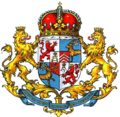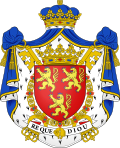Duchy of Sagan
The Duchy of Sagan was created in 1274 through a spin-off from the Duchy of Glogau . Under Duke Heinrich IV it was subordinated to the Crown of Bohemia as a fiefdom in 1329 and was ruled by the Glogau branch of the Silesian Piasts until 1472 . Then it came successively to the Saxon Wettins , Albrecht von Wallenstein , the Bohemian Lobkowitz and the Courland Duke Peter von Biron and his descendants. After the First Silesian War , in 1742 almost all of Silesia fell to Prussia . In 1844 it was constituted by the Prussian King Friedrich Wilhelm IV. As the Prussian throne of the Principality of Sagan , which existed until 1919. The place of residence was the city of Sagan (today Żagań in the Lubusz Voivodeship in Poland).
history
After the death of Duke Konrad II of Silesia in 1273/74, his heir was passed to his three sons, Konrad III. "Köberlein" , Primislaus I. and Heinrich III. divided. The area of Sagan was for Konrad III. "Köberlein" outsourced. Since Primislaus I died in 1289, Sagan fell after Konrad III. Death to Heinrich III in 1304. "Sperling", who in turn associated it with Glogau. He died in 1309 and left the sons of Heinrich IV. "The Faithful" , Konrad I , Boleslaus , Johann and Primislaus II. They initially managed their inheritance together under the tutelage of their mother Mechthild until 1312. To prevent their territories from being split up, they first divided their property into two parts on February 29, 1312, with Henry IV and his two youngest brothers Johann and Primislaus / Primko II receiving the western area with Sagan. In 1314 they lost Sagan, among others, which their relative, the Brandenburg Margrave Waldemar , had appropriated by way of pledge. After his death in 1319 they got it back and divided it up again. Sagan fell to Henry IV, who now dubbed Duke of Sagan . In 1329 he voluntarily handed over his territory in Breslau as a fiefdom to the Bohemian King John of Luxembourg and thus to the Crown of Bohemia , which was confirmed in 1335 with the Treaty of Trenčín .
After Heinrich IV's death in 1342, he was followed by his son of the same name, Heinrich V "the Iron" as the sole heir. He left the sons of Heinrich VI in 1369 . d. Ä. , Heinrich VII. "Rumpold" and Heinrich VIII. They administered their inheritance together until 1378, then Heinrich VI dubbed it. d. Ä. as the Duke of Sagan . After his death in 1393 he was followed by Henry VIII "Sperling", who connected Sagan with his half of the ducal Glogau. Since at his death in 1397 his sons Johann I , Heinrich IX. , Heinrich X. and Wenzel were still minors, until 1403 they ruled the undivided inheritance together with their mother, under the tutelage of their uncle Ruprecht I of Liegnitz. In 1403 the eldest brother Johann I took over the reign of Sagan and ducal Glogau, at the same time for his younger brothers. In 1413 the now independent area of Sagan was spun off for him, while at the same time he had to renounce the succession in the ducal part of Glogau. In 1414 he could from the v. Hakenborn acquire the (Lower) Lausitzian rule of Priebus . It was thereby attached to the Duchy of Sagan and thus to Silesia. Like his brothers, Johann paid homage to the Bohemian sovereign Sigmund in Breslau in 1420 . After the death of his brother Heinrich X. in 1423, John I, who refused to be satisfied with Sagan, feuded with his brother Heinrich IX. the inheritance of Heinrich X.
Johann I died in 1439 and bequeathed Sagan to his four sons Balthasar , Rudolf , Wenzel and Johann II. He led his father's battle for Glogau against Heinrich IX. away. With a partition treaty concluded in 1450, the eldest brother Balthasar received the Duchy of Sagan and Johann II. The area separated from it by Priebus . Since Johann II felt disadvantaged, he contested his property with Balthasar and in 1461 seized Sagans. Balthasar, who was a supporter of the Bohemian King George of Podebrady , succeeded in retaking Sagan in 1467, but John II, who supported the opposing king Matthias Corvinus , took it again in 1472. He had his brother Balthasar arrested in the round tower of the city fortress Priebus, where he died of starvation on July 15, 1472. Then Johann II reunited the dominions of Priebus and Sagan and sold the duchy in the same year on December 12th to the Saxon Duke Albrecht the Courageous .
During the rule of the Wettins , who introduced the Reformation in the Principality of Sagan , the affiliation to Silesia was relaxed. In 1549, Duke Moritz von Sachsen Sagan had to cede to the Bohemian sovereign King Ferdinand I , who gave him some Bohemian enclaves in exchange. As a result, Ferdinand I succeeded in eliminating the Wettin family from among the Silesian princes. Three years later Ferdinand I. gave Sagan a pledge to Margrave Georg Friedrich I von Hohenzollern , who in exchange had to forego the Duchy of Opole - Ratibor . After the pledge was released by the Crown of Bohemia, however, he lost it in 1558. In the same year Ferdinand I pledged it to the Breslau bishop Balthasar von Promnitz . After his death in 1562 it was inherited by his nephew Seyfried von Promnitz , whose descendants kept it until 1601.
In 1628, Emperor Ferdinand II, in his capacity as King of Bohemia, transferred the fallen fiefdom to his general Albrecht von Wallenstein, and at the same time raised it again to a duchy. After Wallenstein's death in 1634, the Duchy of Sagan was confiscated by Ferdinand II, who on July 2, 1646 left it to his supporters, Prince Wenzel Eusebius von Lobkowitz auf Raudnitz , who dubbed it as the Duke of Sagan.

Lobkowitz initially did not pursue the Counter-Reformation initiated by Wallenstein . The 1,602 sold to the city of Sagan Chamber goods he bought back determined and pulled out a completed fiefdom. This enabled him to expand the duchy's property considerably. He had the Sagan Castle rebuilt according to plans by the Italian architect Antonio della Porta . More than a century later, his descendant Joseph Franz Maximilian von Lobkowitz († 1816) sold the Principality of Sagan on March 29, 1786 to Duke Peter von Biron from Courland , who died in 1800. He was followed by his eldest daughter Wilhelmine , who was inherited by her sister Pauline in 1839 . It was bought by her sister Dorothea in 1842 , who was married to Count Edmond de Talleyrand-Périgord , a nephew of the French Foreign Minister Charles-Maurice de Talleyrand . For them and their descendants, the Prussian King Friedrich Wilhelm IV created the Prussian Throne Fief Principality of Sagan in 1844 , whose prince was a member of the Silesian provincial parliament and the Prussian manor house . In 1929 the title of duke expired, in 1935 the feudal status.
Politically, the area formed from 1741 the Silesian district of Sagan , which was dissolved in 1932 and transferred to the districts of Sprottau , Grünberg i. Schles. and Rothenburg (Ob. Laus.) was divided. Until the expropriation in 1945, the former estate with the Sagan Castle remained in the possession of the Dukes of Talleyrand-Périgord .
Dukes of Sagan
- 1273 / 74-1304 Conrad III. "Köberlein"
- 1314–1319 as pledge to Waldemar von Brandenburg
- 1319–1342 Henry IV.
- 1342–1369 Heinrich V "the Iron"
- 1369–1378 Heinrich VI. d. Ä. together with Heinrich VII. Rumpold and Heinrich VIII. "Sperling"
- 1378–1393 Heinrich VI. d. Ä.
- 1393–1397 Henry VIII. "Sperling"
- 1403–1413 Johann I , as guardian of his brothers
- 1413–1439 Johann I.
- 1439–1450 Balthasar II. , Together with the younger brothers Rudolf , Wenzel and Johann II.
- 1450–1454 Balthasar II. Together with Rudolf († 1454)
- 1454–1461 and 1467–1472 Balthasar II.
- 1461–1467 and 1472 Johann II.
- 1472–1500 Albrecht the Courageous , Duke of Saxony
- 1500–1539 George the Bearded , Duke of Saxony
- 1539–1541 Heinrich the Pious , Duke of Saxony and Margrave of Meissen
- 1541–1549 Moritz von Sachsen , Duke of Saxony and Elector
- 1549 revert to the Crown of Bohemia
- 1553–1601 pledged to the barons of Promnitz
- 1628–1634 Albrecht von Wallenstein
- 1634 confiscated for the crown of Bohemia
- 1646–1677 Wenzel Eusebius von Lobkowitz , President of the Court Council (House Lobkowicz )
- 1677–1715 Ferdinand August von Lobkowitz
- 1715–1737 Philipp Hyazinth von Lobkowitz
- 1737–1739 Wenzel Ferdinand Karl von Lobkowitz
- 1739–1784 Ferdinand Philipp von Lobkowitz
- 1784–1786 Joseph Franz Maximilian von Lobkowitz († 1816)
- 1786–1800 Peter von Biron , Duke of Courland and Semgallia (House of Biron of Curland )
- 1800–1839 Wilhelmine von Sagan
- 1839–1842 Pauline von Sagan
- 1842–1862 Dorothea von Sagan ∞ Edmond de Talleyrand-Périgord (House Talleyrand-Périgord )
- 1862–1898 Napoleon Louis de Talleyrand-Perigord († 1898)
- 1898–1910 Boson de Talleyrand-Perigord († 1910)
- 1910–1929 Hélie de Talleyrand-Perigord († 1937)
- (Dynastic successor :) Helen Violette de Talleyrand-Périgord, Duchess of Sagan (1915–2003), married Countess of Pourtalès
literature
- Karl August Müller: Patriotic images, or history and description of all castles and knight palaces in Silesia and the county of Glatz. Second edition, Glogau 1844, pp. 222–229.
- Otto Wolff : Critical review of the history of the city and the Duchy of Sagan, as presented by A. Leipelt, mathematician at the royal Catholic high school in Sagan . Grünberg 1854 ( e-copy ).
- A. Leipelt: History of the city and the Duchy of Sagan . Sorau 1853 ( e-copy ).
- Friedrich-Albert Zimmermann: Contributions to the description of Silesia . Volume 7, Brieg 1787, pp. 7-116.
- Günter Erbe : Dorothea Duchess of Sagan (1793–1862). A Franco-German career (New Research on Silesian History, Vol. 18), Cologne / Weimar / Vienna 2009, ISBN 978-3-412-20415-0 .
- Historical Commission for Silesia (Ed.): Geschichte Schlesiens , Vol. 1, Sigmaringen 1988, ISBN 3-7995-6341-5 , pp. 124, 207 and 289.
- ditto, Vol. 2, ISBN 3-7995-6342-3 , pp. 3, 12, 15, 17, 58 and 65.
- Hugo Weczerka (Hrsg.): Handbook of the historical places . Volume: Silesia (= Kröner's pocket edition . Volume 316). Kröner, Stuttgart 1977, ISBN 3-520-31601-3 , pp. 462–467 and family tree on pp. 594–595.
- Rudolf Žáček: Dějiny Slezska v datech . Praha 2004, ISBN 80-7277-172-8 , pp. 454-456
Web links
Individual evidence
- ^ Anton Leipelt: History of the city and the Duchy of Sagan. 277 p., Sorau, Rauert, 1853 Online at Google Books (p. 186)
- ↑ http://territorial.de/ndschles/sprottau/landkrs.htm






